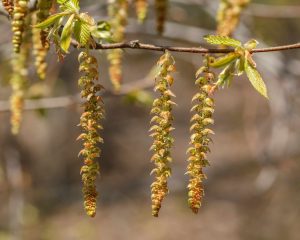Blue Beech, Hornbeam or Musclewood, Carpinus caroliniana
Photo by Jim Robbins, CC BY-NC-ND 4.0

Photo by Tom Potterfield
Height: to about 30 feet
Spread: 15-25 feet
LANDSCAPE USE
Excellent for rich, shaded woodlands or as a specimen in areas free of root disturbance. DO NOT USE IN PARKING ISLANDS — this tree needs lots of root space and does not like compacted soils.
FORM
A small to medium-sized, erect, straight-trunked, deciduous tree with tight, grayish, fluted bark and a rounded to irregular crown of shiny green, doubly toothed leaves.
NATIVE RANGE
Calcareous hammocks and flood plains. Wide ranging native, from Nova Scotia and Minnesota, southward to central peninsular Florida, and west Texas.
CHARACTERISTICS
Flowers: Greenish, small, with male and female flowers borne in separate catkins. Male flowers borne in cylindrical catkins. Female flowers subtended by attractive, 3-lobed bracts. Early spring.
Leaves: Alternate, simple, 2-5 inches long, to about 2 inches wide, shiny above, margins sharply and doubly toothed, veins paired and parallel.
Fruit: A tiny nutlet borne at the base of a 3-lobed bract.
Bark: Bluish gray, smooth, sinewy, and fluted, having a muscular appearance, hence one of the common names (Musclewood).
CULTURE
Soil: Prefers rich, moist, acid to neutral soil.
Exposure: Shade to part shade.
Water: Occurs naturally in moist to wet situations. Will tolerate periodic flooding.
Hardiness Zones: 2-9
Life Span: Long-lived; 150 years or more.
BEST FEATURES including WILDLIFE SUPPORT
Slow growing and long-lived. Interesting bark. Shade tolerant. Fall color. Larval food plant for Eastern Tiger Swallowtail and Red-spotted Purple Butterflies. Reported for many moth species also. Wildlife food. Web worms are not a problem, they do not harm the trees as they appear when the trees are going dormant, and the web worms are a critical source of food for migrating birds.
COMPANION PLANTS
Live oak and Laurel Oak (Quercus virginiana and Q. Iaurifolia), Sweetgum (Liquidambar styraciflua), Loblolly and Shortleaf Pines (Pinus taeda and P. echinata), Beautyberry (Callicarpa amcricana), Highbush Blueberries (Vaccinium spp.), Virginia Creeper (Parthenocissus quinquefolia), Carolina Jessamine (Gelsemium sempervirens), Flowering Dogwood (Cornus florida), Hickories (Carya spp.), Magnolia (Magnolia grandiflora).
DISADVANTAGES
Does not tolerate root disturbance. Difficult to transplant.
CULTIVARS
At least two cultivars are reported but are not generally available in Florida.
ALLERGENIC AND TOXIC PROPERTIES
Pollen may be an airborne allergen.
SIMILAR AND RELATED SPECIES
The American Hop Hornbeam (Ostrya virginiana), also of the birch family, is closely related and somewhat similar. It has shaggy bark and occurs on better-drained sites. Why do we have two native trees with similar and confusing common names? American Hophornbeam, Ostrya virginiana, and American Hornbeam, Carpinus caroliniana – what are the differences? Here’s a nice agriculture extension resource to explain the differences: https://ask.extension.org/kb/faq.php?id=858363